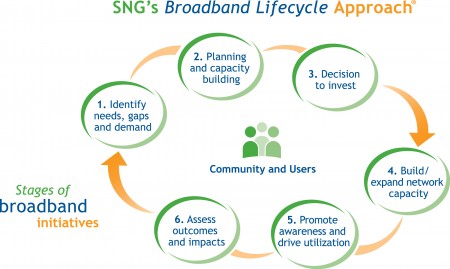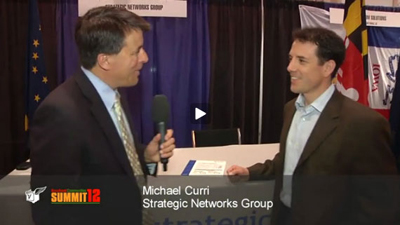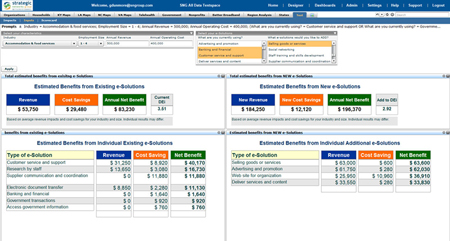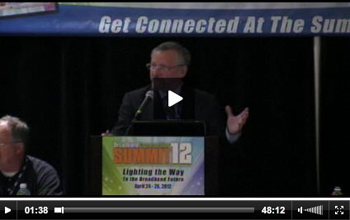April 2012: Recapping the Dallas Broadband Summit
Big Hats, Big Questions, and Big Broadband
The Question “What’s Next?” Dominates Broadband Summit
by Doug Adams
This year’s preeminent question for most attendees at the Broadband Summit in Dallas seemed to be “What’s Next?”
 With builds nearing completion, many American States are in the throes of step 4 of the broadband lifecycle, left to wonder… what do we do now? How do we drive adoption? And at SNG we’d add…how do we turn adoption into utilization?
With builds nearing completion, many American States are in the throes of step 4 of the broadband lifecycle, left to wonder… what do we do now? How do we drive adoption? And at SNG we’d add…how do we turn adoption into utilization?
So along the lifecycle, many regions in the U.S. have gotten the “supply side” of broadband down (building the network).

In an interview on the conference floor, Michael Curri explains the importance of the "demand side" of broadband... and how SNG can help.
SNG Unveils DEi Calculator in Dallas
What’s Your Broadband IQ?
We were thrilled to receive rave reviews with the introduction of our DEi Calculator in Dallas.
 Businesses, organizations, and individuals can use the DEi calculator as a companion to the Digital Economy index (DEi) Scorecard, both designed to help them understand how to embrace new technologies and business practices, and leverage e-solutions to grow and enhance their opportunties.
Businesses, organizations, and individuals can use the DEi calculator as a companion to the Digital Economy index (DEi) Scorecard, both designed to help them understand how to embrace new technologies and business practices, and leverage e-solutions to grow and enhance their opportunties.
SNG’s Digital Economy index (DEi) Scorecard and online DEi Impact Calculator gives end-users the power and insights of years of SNG’s broadband research. Users can quickly identify ways to be more effective, productive, and competitive by leveraging broadband by comparing themselves against tens of thousands of their peers in SNG’s database.
The DEi Scorecard and DEi Impact Calculator are an excellent solution to help drive utilization of e-solutions, of utmost interest to:
- Carriers looking for new subscribers or current subscribers to upgrade to fiber
- Economic development agencies looking to give their constituents a roadmap to maintain and grow their business using broadband
- Broadband project managers looking to drive uptake and use of their ultra-fast broadband network
Regions and economic development agencies are excited about the possibility of putting this tool in the hands of their constituents, helping them understand… How does a local business compare to the competition? What are other organizations doing better to leverage broadband? What are the benefits of broadband that individuals should be leveraging? Learn More>>
(Almost) Live From Dallas
Once again, Jim Baller and broadbandus.tv did great work broadcasting many sessions from the Broadband Summit. If you haven’t already, we would encourage you to visit the site… it does require a one-time registration. Michael Curri moderated a jam-pack  ed session examining the challenges of transitioning from build mode to utilization.
ed session examining the challenges of transitioning from build mode to utilization.
Winning Strategies for the Emerging Knowledge Economy included panelists Bruce Abraham (North Georgia Network), Donny Smith (Jaguar Communications), Kyle Hollifield (Bristol Virginia Utilities), and Betty Zeman (Cedar Falls Utilities).
For a copy of the PowerPoint from this session, click here.
What’s Next… Industry Luminary Insights
Larry Strickling, NTIA
The Honorable Lawrence E. Strickling, Assistant Secretary of Commerce, Administrator, National Telecommunications and Information Administration (NTIA) gave the keynote address at the Broadband Summit, he summed up the U.S. governments “what’s next” in 5 steps…
1) Remain dedicated to make sure grantees complete projects on time and on budget.
2) Finding opportunities to expand projects where build savings can be leveraged.
3) Conduct a multi-year evaluation program in place to measure ROI and inform future decisions
4) Use the recently passed legislation to enact a national public safety broadband network to help reach even more rural areas with broadband
5) Upon completion of grants, deploy the NTIA team to drive access in America.
James Salter, AEG
Chairman of Atlantic Engineering Group (AEG), James Salter was extremely entertaining as he looked both backward and forward.
Salter had both praise and criticism for the stimulus program. Kudos for recognizing that rural broadband is “basic infrastructure” and concern for the amount of time it has taken to get things approved and moving – a natural problem given the resources available to administer this massive task.
So the question he examined was – now what… when it comes to rural broadband?
Salter compares the need for further government involvement and investment, much like we saw in the 1930’s, driving electricity to homes everywhere.
And he sees the capacity to fund only one network in rural America – it does not matter who does it. His argument was that it is not profitable or possible to have more than one carrier survive in a competitive environment. The pure math is that there is not a big enough pie for carriers to be fighting over customers – and whatever network provides “triple play” services (TV, broadband and phone) also needs to be robust enough to serve all of the community’s broadband needs.



